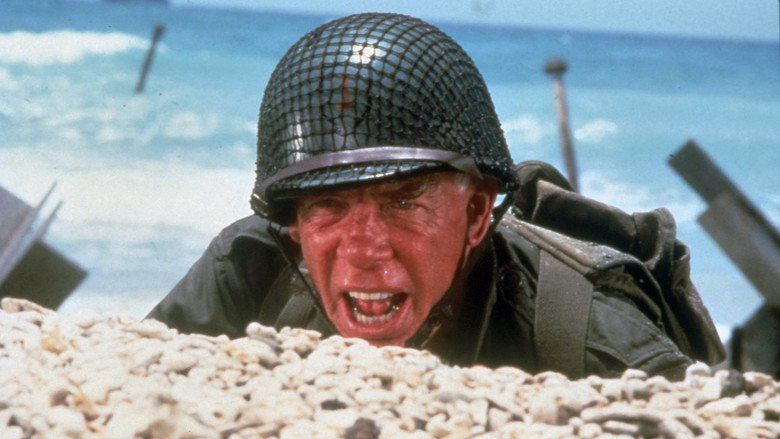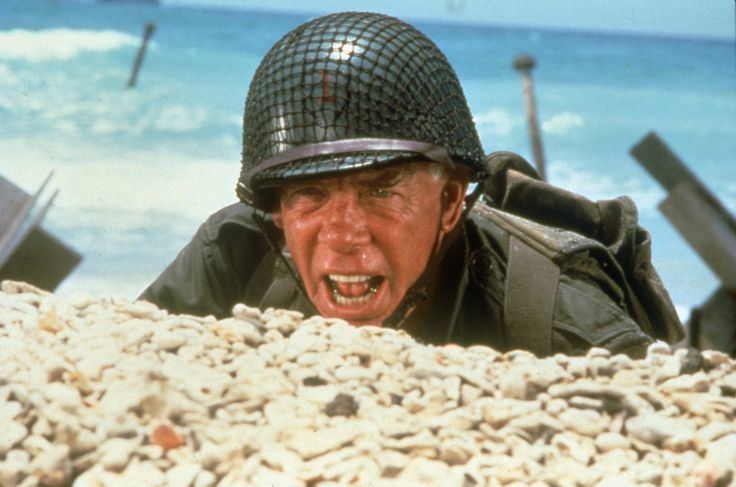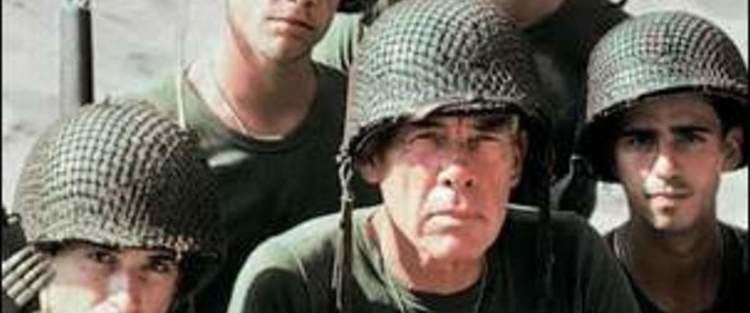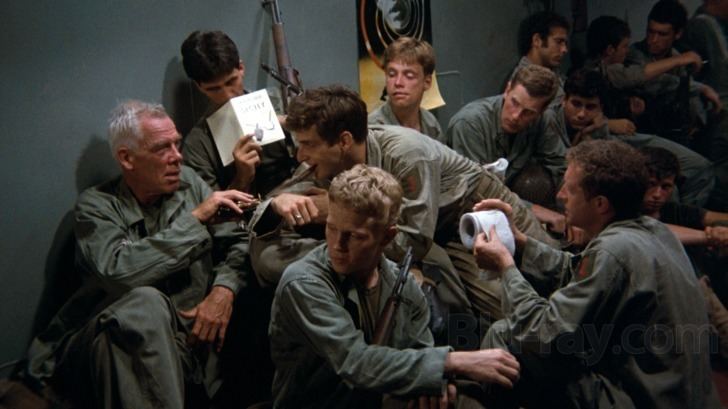The Big Red One
8.4 /10 1 Votes
4/4 Roger Ebert 3.8/5 Amazon Genre Action, Drama, War Music director Dana Kaproff Language English | 7.2/10 IMDb 91% Rotten Tomatoes Initial DVD release April 27, 1999 Duration Country United States | |||||||||||||||||||||||||||||||||
 | ||||||||||||||||||||||||||||||||||
Release date July 18, 1980 Cast (The Sergeant), (Pvt. Griff, 1st Squad), (Pvt. Zab, 1st Squad), (Pvt. Vinci, 1st Squad), (Pvt. Johnson, 1st Squad), (Underground Walloon fighter at asylum) Similar movies Madagascar: Escape 2 Africa , Out of Africa , The Lion King 2: Simba's Pride , The Lion King 1½ , The African Queen , George of the Jungle Tagline Only chance could have thrown them together. Now, nothing can pull them apart. | ||||||||||||||||||||||||||||||||||
Having previously fought in World War I, an unnamed sergeant (Lee Marvin) now leads soldiers of the U.S. First Infantry Division through World War II. His men include conflicted marksman Pvt. Griff (Mark Hamill), pulp novel writer Pvt. Zab (Robert Carradine), Sicilian Pvt. Vinci (Bobby Di Cicco) and medic Pvt. Johnson (Kelly Ward). The soldiers adapt to the hardships of war as they see conflict in North Africa and Sicily, take part in the D-Day landings, and liberate a Nazi concentration camp.
Contents

The Big Red One is a World War II war film starring Lee Marvin and Mark Hamill, released in 1980. It was written and directed by Samuel Fuller.
It was heavily cut on its original release, but a restored version, The Big Red One: The Reconstruction, was premiered at the 2004 Cannes Film Festival, seven years after Fullers death. Fuller wrote a book, with the same title, which was more a companion novel than a novelization of the film, although it features many of the scenes that were originally cut.

A veteran sergeant of the World War I leads a squad in World War II, always in the company of the survivor Pvt. Griff, the writer Pvt. Zab, the Sicilian Pvt. Vinci and Pvt. Johnson in Vichy French Africa, Sicily, D-Day at Omaha Beach, Belgium and France, ending in a concentration camp in Czechoslovakia where they face the true horror of war.
Background

Fuller was a World War II veteran and served with the 1st Infantry Division, which is nicknamed The Big Red One for the red numeral "1" on the Divisions shoulder patch. He received the Silver Star, Bronze Star and Purple Heart during his service. He was present at the liberation of the Falkenau concentration camp.
Plot

The film begins in black and white in November 1918 at the end of World War I. A private (Marvin), using his trench knife, kills a German soldier who was approaching with his arms raised and muttering in German. When he returns to his companys headquarters, the private is told that the "wars been over for four hours." The 1st Division patch is shown in color.

The film then moves to November 1942, when the soldier, now a sergeant in the "Big Red One", leads his squad of infantrymen through North Africa. Over the next two years the squad serves in campaigns in Sicily, Omaha Beach at the start of the Normandy Campaign, the liberation of France and the invasion of western Germany.

Throughout the film, Sgt. Possums German counterpart, Schroeder, participates in many of the same battles and displays a ruthless loyalty to Hitler and Germany. At different times he and the sergeant express the same sentiment that soldiers are killers but not murderers.

During the advance across northern France the squad crosses the same field where the sergeant killed the surrendering German at the start of the film, where a memorial now stands. The following short conversation takes place:
Johnson: Would you look at how fast they put up the names of all our guys who got killed?Sgt. Possum: Thats a World War One memorial.Johnson: But the names are the same.Sgt. Possum: They always are.The squads final action in the war is the liberation of Falkenau concentration camp in Czechoslovakia. Shortly after this, the sergeant is in a forest at night, having just buried a young boy he had befriended after liberating the camp. Schroeder approaches, attempting to surrender, but the sergeant stabs him. His squad then arrives and informs him that the war ended "about four hours ago." This time, as the squad walks away, Pvt. Griff (Mark Hamill) notices that Schroeder is still alive; the sergeant and his men work frantically to save his life as they return to their encampment.
Cast
Restored scenes
Production
Warner Brothers Studio was interested in filming The Big Red One in the late 1950s, sending Fuller on a trip to Europe to scout locations. Fuller directed Merrills Marauders as a dry run for the film. When Fuller argued with Jack L. Warner and his studio over cuts they made to Merrills Marauders, the plans for the film The Big Red One were dropped.
Originally, John Wayne was to play the sergeant, but Fuller felt that he was not right for the role.
Peter Bogdanovich helped set up the film at Paramount Pictures, which paid Fuller to write a script. However, when Paramount head Frank Yablans left the studio, the project was in turnaround. It shifted over to Lorimar with Bogdanovich to produce (he says Fuller wanted him to play the Robert Carradine part) but then Bogdanovich pulled out and brought in Gene Corman to produce.
The film was shot on location in Israel and Ireland, with some snow scenes featuring Marvin shot in and around Big Bear National Park. Trim Castle in Trim, County Meath was used as the derelict castle where the adolescent sniper kills one of the GIs (Boyne) as he crosses the river.
Originally rated PG by the MPAA, the film reconstruction by Brian Jamieson and Richard Schickel was re-rated R for "war violence and some language".
Similar Movies
Saving Private Ryan (1998). Lee Marvin appears in The Big Red One and Attack. Lee Marvin appears in The Big Red One and The Dirty Dozen. Hell Is for Heroes (1962). The Victors (1963).
Reception
The Big Red One ranks 483rd on Empire magazines 2008 list of the 500 greatest movies of all time. Terry Lawson of the Detroit Free Press called it the greatest war movie of all time.
The film was entered into the 1980 Cannes Film Festival.
In his review of the original, theatrical version of the film, Roger Ebert wrote:
While this is an expensive epic, he hasnt fallen to the temptations of the epic form. He doesnt give us a lot of phony meaning, as if to justify the scope of the production. There arent a lot of deep, significant speeches. In the ways that count, "The Big Red One" is still a B-movie – hard-boiled, filled with action, held together by male camaraderie, directed with a lean economy of action. Its one of the most expensive B-pictures ever made, and I think that helps it fit the subject. "A" war movies are about War, but "B" war movies are about soldiers.
In November 21, 2004, Roger Ebert added The Big Red One to his list of "great movies".
It is currently listed "Certified Fresh" by the critical website Rottentomatoes.com with a 91% rating and aggregate score of 7.7 based on 44 reviews. On the re-edited version of the film, Rotten Tomatoes consensus states that "The reconstruction of Samuel Fullers epic account of his days in North Africa in World War II elevates the film into the pantheon of great war movies."
References
The Big Red One WikipediaThe Big Red One IMDbThe Big Red One Roger EbertThe Big Red One Rotten TomatoesThe Big Red One Amazon.comThe Big Red One themoviedb.org
